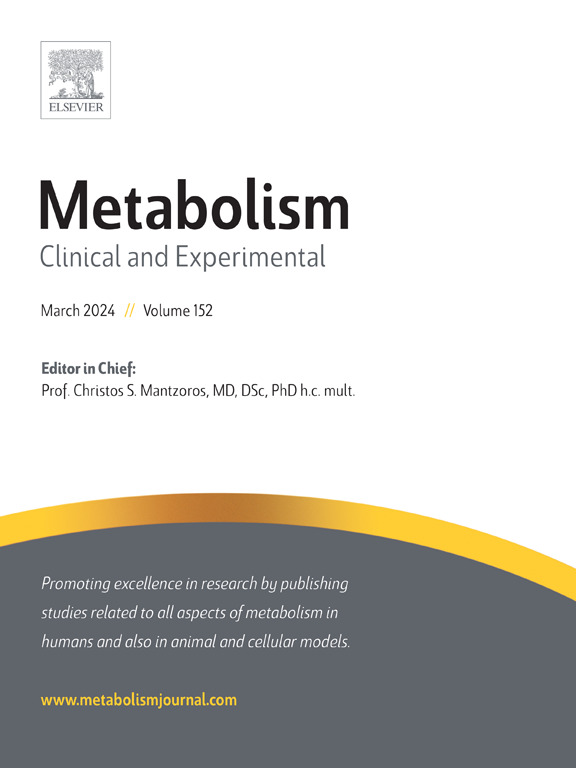TRIM在代谢调节中的新作用
IF 11.9
1区 医学
Q1 ENDOCRINOLOGY & METABOLISM
引用次数: 0
摘要
最近的发现扩大了我们对TRIM蛋白家族的理解,将这些蛋白定位为细胞代谢和细胞命运的关键调节因子。TRIM蛋白主要作为多功能E3泛素连接酶,通过泛素化依赖和非泛素化机制(如寡聚化和表观遗传修饰)协调关键的代谢途径,包括葡萄糖、脂质和氨基酸代谢。例如,据报道,TRIM38、TRIM11和TRIM24通过靶向关键的葡萄糖转运体和糖酵解酶来调节糖酵解通量和胰岛素信号传导,从而影响模型系统中的癌症代谢和胰岛素反应。同样,TRIM21和TRIM56与脂肪酸合成、氧化和胆固醇平衡有关,可能与脂肪肝和动脉粥样硬化有关。此外,trimm介导的氨基酸代谢调节-特别是通过谷氨酰胺和支链氨基酸的途径-在肿瘤代谢重编程和生存中起着核心作用。除了酶的调节,TRIM蛋白通过表观遗传调节和与信号网络的相互作用发挥非规范功能。这篇综述综合了目前对TRIM蛋白在代谢控制和细胞死亡中的多方面作用的认识,表明铁死亡可能将TRIM蛋白与脂质和氨基酸代谢联系起来,并强调了TRIM蛋白与代谢应激之间的联系是未来研究的一个关键领域。本文章由计算机程序翻译,如有差异,请以英文原文为准。

Emerging roles of TRIM in metabolic regulation
Recent findings have broadened our understanding of the tripartite motif (TRIM) protein family, positioning these proteins as pivotal regulators of cellular metabolism and cell fate. Primarily functioning as versatile E3 ubiquitin ligases, TRIM proteins orchestrate key metabolic pathways—including glucose, lipid, and amino acid metabolism—through both ubiquitination-dependent and -independent mechanisms such as oligomerization and epigenetic modification. For example, TRIM38, TRIM11, and TRIM24 have been reported to modulate glycolytic flux and insulin signaling by targeting key glucose transporters and glycolytic enzymes, with effects on cancer metabolism and insulin responses in model systems. Similarly, TRIM21 and TRIM56 have been implicated in fatty acid synthesis, oxidation, and cholesterol balance, with potential relevance to fatty-liver conditions and atherosclerosis. Moreover, TRIM-mediated regulation of amino acid metabolism-particularly through pathways involving glutamine and branched-chain amino acids-plays a central role in tumor metabolic reprogramming and survival. Beyond enzymatic regulation, TRIM proteins exert non-canonical functions through epigenetic modulation and interactions with signaling networks. This review synthesizes current insights into the multifaceted roles of TRIM proteins in metabolic control and cell death, suggesting that ferroptosis may link TRIM proteins to lipid and amino acid metabolism, and highlights the connection between TRIM proteins and metabolic stress as a key area for future research.
求助全文
通过发布文献求助,成功后即可免费获取论文全文。
去求助
来源期刊

Metabolism: clinical and experimental
医学-内分泌学与代谢
CiteScore
18.90
自引率
3.10%
发文量
310
审稿时长
16 days
期刊介绍:
Metabolism upholds research excellence by disseminating high-quality original research, reviews, editorials, and commentaries covering all facets of human metabolism.
Consideration for publication in Metabolism extends to studies in humans, animal, and cellular models, with a particular emphasis on work demonstrating strong translational potential.
The journal addresses a range of topics, including:
- Energy Expenditure and Obesity
- Metabolic Syndrome, Prediabetes, and Diabetes
- Nutrition, Exercise, and the Environment
- Genetics and Genomics, Proteomics, and Metabolomics
- Carbohydrate, Lipid, and Protein Metabolism
- Endocrinology and Hypertension
- Mineral and Bone Metabolism
- Cardiovascular Diseases and Malignancies
- Inflammation in metabolism and immunometabolism
 求助内容:
求助内容: 应助结果提醒方式:
应助结果提醒方式:


